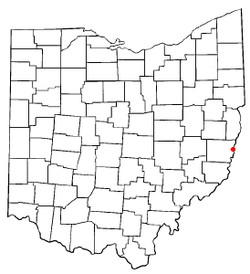Bellaire, Ohio
| Bellaire, Ohio | |
|---|---|
| Village | |

Bellaire on the Ohio River
|
|
| Nickname(s): The All-American Town | |
 Location of Bellaire, Ohio |
|
 Location of Bellaire in Belmont County |
|
| Coordinates: 40°1′N 80°45′W / 40.017°N 80.750°WCoordinates: 40°1′N 80°45′W / 40.017°N 80.750°W | |
| Country | United States |
| State | Ohio |
| County | Belmont |
| Township | Pultney |
| Area | |
| • Total | 1.68 sq mi (4.35 km2) |
| • Land | 1.65 sq mi (4.27 km2) |
| • Water | 0.03 sq mi (0.08 km2) |
| Elevation | 666 ft (203 m) |
| Population (2010) | |
| • Total | 4,278 |
| • Estimate (2012) | 4,220 |
| • Density | 2,592.7/sq mi (1,001.0/km2) |
| Time zone | Eastern (EST) (UTC-5) |
| • Summer (DST) | EDT (UTC-4) |
| ZIP code | 43906 |
| Area code(s) | 740 |
| FIPS code | 39-05074 |
| GNIS feature ID | 1060860 |
| Website | bellaireohio |
Bellaire is a village in Belmont County, Ohio, United States. It is part of the Wheeling, West Virginia Metropolitan Statistical Area, and Wheeling is across the Ohio to the east. The population was 4,278 at the 2010 census, having had its peak in 1920. The village is located along the Ohio River.
The Bellaire toll bridge (now abandoned and closed) was filmed in the 1991 motion picture The Silence of the Lambs. The curved railroad viaduct and bridge over the Ohio, the B & O Railroad Viaduct, were featured in the 2010 film Unstoppable and is a registered historic structure.
Mound builders occupied numerous areas along the Ohio River and built complex earthworks. None of their distinctive prehistoric remains has been found within the present-day city limits.
The Mingo, Shawnee and Delaware were historic tribes who inhabited the area at the time of European encounter and settlement. The latter were involved in the Northwest Indian Wars after settlement began in the post-Revolutionary War years. Unhappy that the United States had ignored their grievances in the 1789 Treaty of Fort Harmar, the Indians tried to push out the settlers over the next several years.
The first documented European visitors to the Ohio River Valley and this area were French trappers and priests in the early and mid-1700s. They were impressed with the river's heavily wooded and hilly shores, and with the abundance of fish and wildlife.
The young George Washington had explored and surveyed lands in the Ohio River Valley before the Revolutionary War. After the war, he supported plans to have the federal government make land grants to veterans as payment for their services, in lieu of cash.
...
Wikipedia
